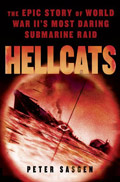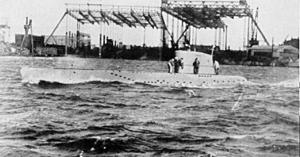History and Development
Professor Hellmuth Walter
Walter was a brilliant engineer that in 1933 worked on a new gas turbine at the Germaniawerft shipyard in Kiel and there his idea of a closed circuit propulsion system was born. He dreamed of making a U-boat that would by driven by hydrogen peroxide
The Proposals
In October 1934 he proposed incredible proposals to OKM (Kriegsmarine high command) namely of a U-boat of some 300 tons (size similar to IIA) with the maximum surface speed of 26 knots and amazing underwater speed of 30 knots! That boat was to have endurance of some 2,500 miles at 15 knots or 500 miles submerged at that speed. The current U-boat of that time (IIA) had a maximum surface speed of 11 knots and could make about 7 knots underwater.
His ideas were rejected promptly by the Kriegsmarine in 1934 as too unconventional and fanciful but Walter did not give up and in 1937 he showed his revised plans to Kapitän zur See Karl Dönitz who was at that time commander of a U-boat training flotilla. Dönitz was so impressed with the proposal that he got it into the proper channels and in 1939 a design contract was made for a small research vessel, called V-80, based on that design.
The first real submarine
The V-80 boat was designed by Walter and Germaniawerft in Kiel and built in the greatest secrecy on a slipway surrounded by a large fence. The boat was launched on April 14, 1940 and the test results carried out during the following spring with Walter himself at the controls were sensational. The boat reached more than 23 knots submerged which was more than double the underwater speed of any submarine in the world at that time (modern nuclear-powered fast-attack submarines like the Soviet Alfa-class are said to reach some 42 knots).
After the prototype
The OKM was so impressed by the test results from V-80 that they suggested immediate construction of six coastal boats based on that design but many in the U-boat department questioned that a real operational boat could be built on this system and also that the shipyards were badly needed to continue delivering the conventional VII and IX U-boats that seemed to be doing what was required of them at that time. A compromise design of a 600-ton boat called V-300 (XVII, later called U-791) that would reach some 19 knots submerged was proposed and construction started at Germaniawerft but was cancelled when Walter found the design to be too slow and proposed his own version of smaller vessels of some 220 tons.
The next generation is born
After a meeting with Dönitz in January 1942 contracts were awarded for 4 boats to be built at Germaniawerft in Kiel (Wk202 - U-792 and U-793) and Blohm & Voss in Hamburg (Wa201 - U-794 and U-795). The keels were laid down in December 1942 for all 4 boats and the first one, U-792 entered water on 28 September 1943 with U-794 on 7 October. These boats were used extensively for training and reached up to 25 knots submerged in 1944, at one such run in March 1944 carried out by U-794 in in the Bay of Danzig Dönitz and 4 other admirals witnessed themselves the
boat reach 24 knots.
In 1942 Walter proposed the huge 1,475ton XVIII that would carry 23 torpedoes and two contracts were awarded on Jan 4, 1943 to Deutsche Werke in Kiel (U-796 and U-797) but they were cancelled on 28 March, 1944 in favour of the XXI which was really a spin-off of the Walter design but with massive battery capacity instead of the Walter turbine that gave the boat 17 knots maximum submerged speed.
The Down side
The Walter boats were extremely complex to build and maintain, also they relied on uncertain supply of
Perhydrol. The fuel was highly flammable and the British abandoned the idea after the war as too
dangerous for combat vessels.
The Walter boats and the outcome of the war
No Walter boats ever saw enemy action and no such boats even entered frontal service as only 3 boats
that were intended for combat were launched before the war was ended and none of them
(U-1405 - U-1407) had been taken through trials and training. Thus the Walter boats did not have any
real effect on the war but they were a very interesting development and according to admiral
Dönitz with a little courage and vision they could have been in service 2 years earlier and then
they certainly would have had enormous impact on the war.
The fate of the Walter boats
All 10 Walter boats (3 not in commission) and the V-80 prototype (which was never commissioned into
the Kriegsmarine officially) were scuttled in May 1945.
Professor Hellmuth Walter passed away in 1980, then 80 years old.




